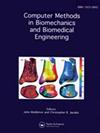心血管疾病的随机参数预测。
IF 1.6
4区 医学
Q3 COMPUTER SCIENCE, INTERDISCIPLINARY APPLICATIONS
Computer Methods in Biomechanics and Biomedical Engineering
Pub Date : 2025-10-09
DOI:10.1080/10255842.2025.2569819
引用次数: 0
摘要
高保真的心血管血流建模需要精确的速度边界数据,这对用于预测动脉粥样硬化等疾病的壁剪应力估计有很大影响。然而,像4D血流MRI这样的体内数据往往是嘈杂的,分辨率低。我们提出了一种结合CFD和集成卡尔曼滤波的随机数据同化方法来实时细化边界估计。在二维和三维血管模型上进行了测试,我们的方法将2D病例的误差降低到3%以下,3D病例的误差降低到7%左右。这种改进的边界准确性增强了患者特异性壁剪切应力预测,支持更可靠的心血管诊断和治疗。本文章由计算机程序翻译,如有差异,请以英文原文为准。
Stochastic parameter prediction in cardiovascular problems.
High-fidelity cardiovascular flow modeling requires accurate velocity boundary data, which strongly affects wall shear stress estimates used to predict diseases such as atherosclerosis. However, in-vivo data like 4D flow MRI are often noisy and low in resolution. We propose a stochastic data assimilation approach combining CFD with an Ensemble Kalman filter to refine boundary estimates in real time. Tested on two- and three-dimensional vascular models, our method reduced errors to below 3% in 2D and about 7% in 3D cases. This improved boundary accuracy enhances patient-specific wall shear stress predictions, supporting more reliable cardiovascular diagnostics and treatments.
求助全文
通过发布文献求助,成功后即可免费获取论文全文。
去求助
来源期刊
CiteScore
4.10
自引率
6.20%
发文量
179
审稿时长
4-8 weeks
期刊介绍:
The primary aims of Computer Methods in Biomechanics and Biomedical Engineering are to provide a means of communicating the advances being made in the areas of biomechanics and biomedical engineering and to stimulate interest in the continually emerging computer based technologies which are being applied in these multidisciplinary subjects. Computer Methods in Biomechanics and Biomedical Engineering will also provide a focus for the importance of integrating the disciplines of engineering with medical technology and clinical expertise. Such integration will have a major impact on health care in the future.

 求助内容:
求助内容: 应助结果提醒方式:
应助结果提醒方式:


